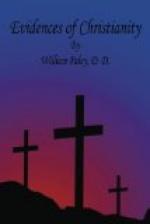I. Basilides lived near the age of the apostles, about the year 120, or, perhaps, sooner. (Lardner, vol. ix. p. 271.) He rejected the Jewish institution, not as spurious, but as proceeding from a being inferior to the true God; and in other respects advanced a scheme of theology widely different from the general doctrine of the Christian church, and which, as it gained over some disciples, was warmly opposed by Christian writers of the second and third century. In these writings there is positive evidence that Basilides received the Gospel of Matthew; and there is no sufficient proof that he rejected any of the other three: on the contrary, it appears that he wrote a commentary upon the Gospel, so copious as to be divided into twenty-four books. (Lardner, vol. ix. ed. 1788, p. 305, 306.)
_________
* The materials of the former part of this section are taken from Dr. Lardner’s History of the Heretics of the first two centuries, published since his death, with additions, by the Rev. Mr. Hogg, of Exeter, and inserted into the ninth volume of his works, of the edition of 1778. _________
II. The Valentinians appeared about the same time. Their heresy consisted in certain notions concerning angelic natures, which can hardly be rendered intelligible to a modern reader. They seem, however, to have acquired as much importance as any of the separatists of that early age. Of this sect, Irenaeus, who wrote A.D. 172, expressly records that they endeavoured to fetch arguments for their opinions from the evangelic and apostolic writings. Heracleon, one of the most celebrated of the sect, and who lived probably so early as the year 125, wrote commentaries upon Luke and John. Some observations also of his upon Matthew are preserved by Origen. Nor is there any reason to doubt that he received the whole New Testament. (Lardner, vol. ix. ed. 1788, pp. 350-351; vol. i. p. 383; vol. ix. ed. 1788, p. 352-353.)
III. The Carpocratians were also an early heresy, little, if at all, later than the two preceding. Some of their opinions resembled what we at this day mean by Socinianism. With respect to the Scriptures, they are specifically charged, by Irenaeus and by Epiphanius, with endeavouring to pervert a passage in Matthew, which amounts to a positive proof that they received that Gospel. Negatively, they are not accused, by their adversaries, of rejecting any part of the New Testament. (Lardner, vol. ix. ed. 1788, pp. 309 & 318.)




